
|
Sale 13
The Benson Collection of U.S. Coins, Part 2
| Flowing Hair and Bust Dollars |
| |
| |
| Lot |
Photo |
Description |
Realized |
Lot 1139 |
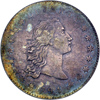 |
1794 Flowing Hair Dollar. PCGS graded EF-40. An excellent example of this rare date that boasts antique silver color and defect free surfaces. There are the usual adjustment marks around the rims of the reverse, with the heaviest left of the first S of STATES, and through the eagle's tail, perch, wreath and rim below. The surfaces show minor circulation hairlines, and both sides have dark toning specks, predominantly on the reverse as illustrated. For a 1794 dollar, this one is well struck, with all the stars visible, and all of the reverse lettering is present, but weak due to the strike and the adjustment marks. Liberty's hair retains good separation on all but the uppermost wave over her ear, which shows the expected wear. We note areas of golden tones around the rims, and there is a small planchet crack through the 1 in the date, starting at the rim left of the digit, up on the left side of the serif, crossing the 1 at the bottom third, into the right field to midway between the 17, then curling back towards the 1. Other identifying features are a small nick between the two upper left points of the sixth star, a spot on the upper inside point of the fourteenth star, and a long adjustment mark down the post of the second T of STATES. PCGS has graded 5 examples as EF-40, one as EF-45, two as AU-55, and six in various mint state grades above.
It is believed that all 1794 dollars were coined on October 15, 1794 from silver bullion deposited by David Rittenhouse, and all 1794 silver dollars coined on this date were delivered to David Rittenhouse (Breen and Collins, in their draft of the 1794 silver dollar manuscript). Thus, all 1794 silver dollars can trace their pedigree to David Rittenhouse, who passed them out to friends, many of whom kept them, others were spent and circulated. The silver bullion deposited by Rittenhouse varied greatly, and there were many gas bubbles in the silver ingots, which later caused laminations and planchets cracks, which plague approximately 30 percent of the 1794 dollar population (as seen here with the faint planchet crack through the 1 in the date).
The 1794 silver dollar is an American classic, it is the first year of issue of our monetary unit, was struck in extremely limited quantities, and the total known population is between 130 and 140 coins in all grades.
Estimated Value $60,000-UP.
After exhaustive searching, this specimen is not recorded in the unpublished Jack Collins and Walter Breen study on 1794 silver dollars, and it is not the specimen offered in July 1997 at the Heritage ANA, which is also PCGS graded EF-40. Apparently, this coin that has traded privately and is not recorded in any auction appearance that we could locate.
View details and enlarged photos
| Realized
$97,750 |
Lot 1140 |
|
Withdrawn
| Unsold |
Lot 1141 |
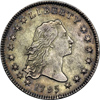 |
1795 Flowing Hair Dollar. Two leaves beneath each wing. VF-30. Here is a rare coin in fairly high grade for this scarce variety. This is thought to be the very first issue of silver dollars from 1795, and it is likely that this coin was included in the first delivery of that year. It is an early die state, before the heavy crack forms on the reverse die through the C of AMERICA. The silver used to coin these was not properly refined and rolled, and many BB-11, B-3 silver dollars show planchet flaws and the coins are often a yellow color instead of silvery gray. This one shows both minor planchet flaws and has the typical yellow color. Identifiable by a small flaw under the 5 of the date, one on the back of Liberty's nose, and another above the E of UNITED near the rim. As to the surfaces, they are very clean for the grade, with no circulation problems other than a few trivial scratches and hairlines from a past cleaning. The rims too are pleasing, with no significant bumps or bruises, although there are some very minor ticks. There does not appear to be a silver plug in this coin, and there are no adjustment marks.
Over the last decade, significant work has been done by this cataloguer to update the condition census of this variety which was published in the Bowers/Borckardt in 1993. First, under their notable specimens the Doolittle, Ostheimer and Davis Graves coins are all the same specimen, which for many years had "SEP" engraved in the field, and these faint initials were expertly buffed out sometime before it was consigned to the Doolittle sale in 1977 (this specimen was just offered in Superior's Elite Sale, January 9, 2002, with no mention of the buffing in the fields and graded AU-55). A recently discovered specimen was offered in Bowers & Merena's Baltimore Sale, November 2001, PCGS graded AU-55 with a silver plug, and another significant offering of this variety was Stack's September, 2000, another silver plug example with the reverse die crack through C of AMERICA which graded EF-45. Further research is still pending on the other notable coins listed, and we hope to publish an update of the Bowers/Borckardt book in the next few years which will bring the notable specimens up to date. This particular coin is certainly in the Condition Census of the top 12 known, and is probably one of the top six for the variety. An opportunity for the specialist to purchase a rare and somewhat unappreciated coin.
Estimated Value $6,000 - 9,000.
From Stack's Sale of June 1995, Lot 392 and the John Haugh collection.
View details and enlarged photos
| Unsold |
Lot 1142 |
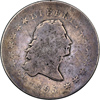 |
1795 Flowing Hair Dollar. Two leaves beneath each wing. Good-5. Yes, the entire coin is double struck with a small shift, but it is apparent on the date, lettering and devices. The obverse has smooth, even wear, while the reverse has even wear but there are 5 large dents around the center. These dents are quite old and toned over, but they are distracting. As to the double striking, the wing, lettering and bust of Liberty all show the doubling plainly. Certainly one of the earliest double strikes known in the bust dollar series, aside from the magnificent 1795 double struck dollar plated in the 1976 edition of the Scott Catalogue & Encyclopedia on page 348. The edge of this coin is not doubled, as that is a separate process from the striking of the obverse and reverse. Certainly an opportunity for a specialist to buy a moderate, and no doubt rare, double struck example of this date.
This cataloguer has seen one other 1795 double struck dollar, that being a BB-15, or B-8 variety, and a few others no doubt exist of other varieties.
Estimated Value $600 - 900.
From Bowers & Merena's Lucien M. LaRiviere Part II Sale, March, 2001, lot 327 and the John Haugh collection.
View details and enlarged photos
| Realized
$1,495 |
Lot 1143 |
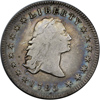 |
1795 Flowing Hair Dollar. Three leaves beneath each wing. PCGS graded VF-20. One of the most common die pairings of the bust dollar series. Lovely steel gray and blue toning in the fields, the central device much lighter on the obverse, the reverse with an arc of dark gray on the lower left side, steel gray elsewhere. Identifiable by two small marks left of the 1 in the date before the star, and a small tick below the first feather of the left wing on the eagle near his body. Excellent rims, color and eye appeal for the grade, and perfect for the type collector.
Estimated Value $1,800 - 2,200.
From the Benson collection and purchased from Ira S. Reed in May 1944 for $17.50. This one comes with a very old envelope probably 100 or so years old describing this coin.
View details and enlarged photos
| Realized
$3,565 |
Lot 1144 |
 |
1795 Flowing Hair Dollar. Silver plug. VF-30. 3 leaves reverse. Discovered by Ray Merena in late 1995, this extraordinary coin added a new layer mystery to the already mysterious "silver plugs" that had been seen on 1795 flowing hair dollars as this one includes adjustment marks. Doug Winter, when cataloguing the Blevin's collection for Superior in 1988 was very close when he noted on lot 3575 "…the centers show an unusual jagged circular cut which gives the impression of a plug; this is mint-made and may represent a die flaw of some sort." A few years later Ken Bressett, Tom Delorey and Roger Burdette discussed these plugs with Q. David Bowers and extensive discussion is included on pages 185/6 of the Bowers/Borckardt Silver Dollar Encyclopedia.
These silver plugs are known on several varieties, but usually on just a few coins of each. It is believed that during the planchet preparation process, sometimes planchets would be slightly underweight, and would normally have to be remelted, drawn and cut to size again. Someone at the Mint decided to use the 1792 silver center cent as an example, and drill out the center of the blank silver dollar planchet, insert a larger silver "plug", and strike the coin normally. The plug would flatten out and become a part of the coin, increasing the weight to the required standard. Ray Merena noted on this specimen that it has not only a silver plug, but also adjustment marks on the lower reverse rim. Why would someone add, then take away weight from the same planchet? Both the silver plug insertion and adjustment marks occurred prior to striking, so we can't be sure which came first, the plug or the adjustment marks.
The coin itself is very choice for the grade, steel gray in color, with rubbed silver high points on the devices and very clean surfaces and rims. The plug is small but can be seen on both sides, and the adjustment marks reside through the eagle's tail feathers and the rim below. Broken out of an NGC slab where it was graded as VF-30.
Estimated Value $4,000 - 6,000.
Sold by Bowers and Merena in their Rarities Sale, August 1999, lot 232 and purchased by John Haugh privately sometime after the sale.
View details and enlarged photos
| Realized
$8,338 |
Lot 1145 |
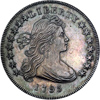 |
1795 Draped Bust Dollar. Off-center bust. ANACS graded MS-60. Toned with jet black colors throughout, the centers slightly lighter in color. We note there are central adjustment marks on Liberty, but they are mostly hidden by her hair and the toning. Boldly struck as are most of this variety, with mountainous hair details on Liberty and even full breast feathers on the eagle. We note some faint hairlines in the fields, and a few scattered marks from handling, none of which are warrant description. Rare and desirable in any grade even approaching mint state, this one will certainly attract considerable attention from type collectors.
This is an important type coin, and it is believed that this is one of the two dies that first introduced the draped bust design coupled with the small eagle reverse to the nation in October of 1795. Few are known that even approach mint state, and this is certainly one of the better ones. An important coin for the collector.
Estimated Value $17,000 - 20,000.
View details and enlarged photos
| Unsold |
Lot 1146 |
 |
1795 Draped Bust Dollar. Off-center bust. PCGS graded AU-58. One of the highlights of the Benson collection, this early dollar embodies the gorgeous toning and general high quality seen on so many of Dr. Benson's coins. The strike is average for variety, with some weakness on the breast of the eagle and mid curls on Liberty. Both sides show deep steel gray at the rims with lighter gray in the fields all with fiery hints of gold and russet luster combine to give this museum quality piece a regal air. The surfaces show minor handling marks from over two centuries of age. We note trivial adjustment marks on the eagle's breast, and this coin can be identified by an "S" shaped lint mark left of the first A in AMERICA.
Over the years we've noticed that a coin which grades About Uncirculated can mean many things. Most show minimal wear, and were obviously circulated for some time. Others, as seen here, probably never circulated, and the surfaces show just trace handling marks. For this reason, the price realized often does not reflect the reported "AU" price, and choice coins sell for far in excess of their technical grade. This particular example certainly has a lot of potential to be a runaway, as the surfaces, color and luster will dazzle all who take the time to examine it.
Estimated Value $5,000 - 7,500.
From the Benson collection and purchased from James G. Macallister in 1944 for $45.00 as "Uncirculated".
View details and enlarged photos
| Realized
$20,700 |
Lot 1147 |
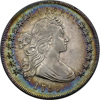 |
1795 Draped Bust Dollar. Off-center bust. PCGS graded EF-45. Lovely old Wayte Raymond toning at the periphery of the obverse and reverse, while the centers remain soft silvery gray. Examination will note a hidden and shallow scratch from the lowest part of ribbon into the field below and through several curls and ending near the 1 in the date. The obverse shows minor adjustment marks, some on the rim near the date, others at the center. We note that the surfaces are generally better than average, and the rims show only one low area above the TY of LIBERTY where we see what appears to be a tiny edge flaw. Nice for the grade assigned.
Estimated Value $3,500 - 4,500.
From the Benson collection and purchased from Ira S. Reed in his final auction sale on March 30, 1946 for $44.00.
View details and enlarged photos
| Realized
$6,613 |
Lot 1148 |
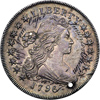 |
1796 Draped Bust Dollar. Small date, large letters. Sharpness of AU-55 but ornately engraved and holed. The obverse of this coin is ornately engraved "A gift from Capt Smith to A Phelan Dec. 7". with the Dec. 7 just above the date 1796. Through Liberty's bust is a moderate hole so the coin could be worn as a necklace. No engraving is noted on the reverse. Both sides show some stray scratches, some of which were used to line up the letters, as well as some file marks on the rim above the last couple of stars and other marks probably occurred during the engraving process. Remarkably, the coin shows very little wear, and the eagle retains nearly full breast feathers.
Who was Capt. Smith? Why did he give such a precious gift to A. Phelan? Obviously, this was a treasured memento and one senses that this coin was cherished by the owner for many years. Toned with a lovely silvery gray hue throughout, and certain to elicit far more questions than answers to the person who buys this piece of American history.
We checked on Genforum on the internet and noted there is a large posting for the "Phelan" family, and with some research feel that the mystery of who gave this coin can someday be unraveled.
We also noted the Baker Library and Historical Collections has a page with several Smith's and a reference to Annie Phelan, which could possibly the person referred to on this coin, and we thank W. David Perkins for his assistance in locating this reference via the search engine Google.
Placing a value on this coin is very difficult. This is certainly far more desirable than the usual holed and scratched Bust dollar, and best of all, this coin has a story to tell. Engraved or counterstamped Bust dollars are extremely rare, and seldom offered. Most transactions are between collectors, so the price paid is not reported. Needless to say, this is an exciting coin and feel that it will remain a cherished item in any collection.
Estimated Value $5,000-UP.
From the John Haugh collection and purchased privately.
View details and enlarged photos
| Unsold |
Lot 1149 |
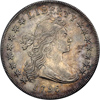 |
1796 Draped Bust Dollar. Small date, large letters. AU-50. A lovely example of this common variety, the surfaces are toned a steel gray with slightly darker areas at the periphery, and traces of luster are noted near the devices. Well struck too, with most of the breast feathers remaining on the eagle and his eye remains sharp. Perfect for the type collector, and the draped bust, small eagle variety is one of the more difficult coins to find in each of the silver denominations. Worth a strong bid from a collector who wants a choice, original coin.
Estimated Value $6,000 - 7,000.
View details and enlarged photos
| Realized
$6,900 |
Lot 1150 |
 |
1796 Draped Bust Dollar. Large date, small letters. NGC graded EF-40. This is almost certainly the famous coin Bolender referred to in his reference work on Early Silver Dollars in 1950 and this was offered in 1952 when Bolender sold his famous collection February 23, 1952. As we know, all Bust dollar errors are extremely rare. In particular, this coin is very unusual in that only one side has been double struck, and what later became the obverse has no evidence of a prior striking. How could this come to pass? Logic dictates that two planchets were accidently fed into the coining press which were approximately lined up, with the planchet used to strike this coin on the bottom. The two planchets were struck, the upper planchet receiving the reverse impression, and this planchet received the obverse impression. The error was discovered, and it is likely that both planchets were restruck. For the coin here, the planchet was flipped over, then restruck. Between UNITED and STATES the date is still plainly visible, along with Liberty's drapery lines and several stars, although these details were flattened out by the second strike. One less spectacular area of note is that Liberty's profile is seen in the clouds below the eagle, her lips and chin just above the bow knot and part of her nose resides on the right ribbon loop. The other planchet used in the initial strike, with the reverse doubled, has apparently been lost, as no auction reports of a double reverse struck 1796 dollar have been located.
As an aside, this die pairing has a deep bubble in the die steel, which had collapsed by the time this coin was struck, leaving a lump between IC of AMERICA, and where this bubble formed in the die the coins struck have a large raised lump in that area. If both sides of this coin were double struck, then this die lump would be located approximately where the 13th and 14th stars are on the obverse, and we see no evidence of the lump in that area.
The coin itself has a lovely gun metal gray color, there are some trivial adjustment marks on the left obverse rim and the surfaces show minimal handling marks and light hairlines. A delightful coin for the specialist.
Our consignor had read about this coin in the Bolender book many years ago, and kept a weather eye out for it, when it appeared, he quickly snatched it up where it became one of the highlights of his error collection. Although we have no photographic or definitive evidence that this is the Bolender coin, we are confident based on the description that this has to be the same specimen sold in his sale of 1952. This coin is also mentioned in the Bowers/Borckardt reference under the notable specimens.
Estimated Value $7,500-UP.
From the Col. Green collection which was purchased and sold by B. G. Johnson and Eric Newman, later in the Gettys collection where it was purchased by Milferd H. Bolender, and sold in his auction sale of his collection, February 23, 1952, lot 26 for $42.00; and more recently it appeared in a Bowers & Merena Rarities Sale, January 1999, Lot 1171 and the John Haugh collection.
View details and enlarged photos
| Realized
$8,050 |
Lot 1151 |
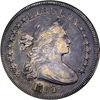 |
1797 Draped Bust Dollar. 9 stars left, 7 right, small letters. ANACS graded EF-40. One of just two reported double struck examples of this scarce variety. On this particular coin, the reverse is double struck with a slight shift between the first and second strikes, and doubling can be seen on the wreath, wings, AMERICA, leaves and ribbon. It is interesting to note that this variety has long been considered rare, but over the past few decades research has shown that at least 100 exist of this variety, but it remains in constant demand by Guide Book, major variety and specialists alike, all of whom need an example of this variety. The surfaces of this coin are average to slightly below, with some toning breaks on the upper points of Liberty's hair and neck, and the reverse shows rim nicks above ITE of UNITED. Minor adjustment marks can be seen around the rim of the reverse, and some light scratches are also present. Toned a deep steel gray, and quite natural in appearance.
Estimated Value $5,000 - 7,000.
From the John Haugh collection and we were unable to trace a prior appearance.
View details and enlarged photos
| Realized
$5,290 |
Lot 1152 |
 |
1797 Draped Bust Dollar. 9 stars left, 7 right, large letters. PCGS graded AU-53. Here is a spectacular error on a high grade 1797 dollar. Not only is the entire coin double struck, but the surfaces show very little wear, and substantial breast feathers remain on the eagle. As to the double striking feature, all design elements show doubling on the obverse and reverse, and the second strike expended most of its energy canceling the first strike, with many areas nearly obliterated, and other areas where the devices are quite bold. All lettering, the date, Liberty, the eagle's wings, head and even eye are all clearly doubled, with just enough of a shift to make it really stand out. The stars are a wonder, showing many extra points and odd shapes. A coin that must be seen to be fully appreciated. When this mint error last auctioned in 1997, Mark Borckardt mentioned that it might even be triple struck, which is entirely possible as the devices show many fragments from the prior strike or strikes. There is a small edge flaw near the bust tip on the obverse, and this will help identify this coin in the future. Lightly cleaned long ago, with faint hairlines, and now toned a lustrous golden gray color.
Estimated Value $8,000 - 12,000.
From Bowers and Merena's Sale, November 1997, lot 1012 to Jim Matthews and purchased privately by John Haugh.
View details and enlarged photos
| Realized
$23,000 |
Lot 1153 |
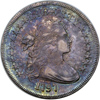 |
1797 Draped Bust Dollar. 9 stars left, 7 right, large letters. PCGS graded EF-45. Extraordinary quality for any bust dollar, with memorable blue and gray toning throughout, and luster remains in the protected areas. A later die state, the obverse had all but shattered when this one was struck, and numerous light cracks can be seen as described in the Bower/Borckardt or Bolender reference, the reverse die had not cracked when this one was struck. Minor weakness is noted around the center of the obverse, as usual for the die state, and we note a very faint pin scratch above ERTY to the two stars nearby, and on the reverse there is a trivial gouge left and below the U of UNITED. The reverse die was rotated about 30 degrees clockwise when this one was struck. Well over half the eagle's breast feathers are sharp, and this coin is easily in the top few percent of those known of the date for eye appeal as well as technical grade.
Estimated Value $4,000 - 4,500.
From the Benson collection and purchased from B. Max Mehl on May 4, 1946 for $35.00, with the note "rare so choice" and we absolutely agree with that.
View details and enlarged photos
| Realized
$9,488 |
Lot 1154 |
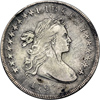 |
1797 Draped Bust Dollar. 10 stars left, 6 right. Sharpness of Fine-15 but cleaned. This one has been cleaned in the past, and we note some dark patina clinging near the devices, especially on the reverse, and this coin may have been exposed to a hostile environment at some time in the past. Here is another spectacular double strike, although in a more moderate grade. The separation between the strikes was approximately 1 millimeter. We note a rim bump on the obverse at 11:00 o'clock, and a scratch down Liberty's face and neck from her ear. Not the prettiest coin in this collection, but quite interesting for the specialist in errors.
Estimated Value $2,000 - 3,500.
From Bowers & Merena's LaRiviere Part II Sale, March 2001, Lot 329 and the John Haugh collection.
View details and enlarged photos
| Realized
$4,255 |
Lot 1155 |
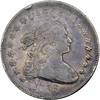 |
1798 Draped Bust Dollar. Small eagle reverse, 15 stars on obverse. Fine-15 obverse, Good-5 reverse. Here is one of John Haugh's favorite early dollar errors. It comes with a custom Capital Plastics holder which describes the coin as a triple strike, one of the only triple struck Bust dollars known outside the Smithsonian Institution. Further, Mr. Haugh had several notable specialists like Jules Reiver and Ken Bressett examine the coin, most of which agreed that it was indeed triple struck, and signed an informal note to that effect which is included with this lot. One person who examined the coin was certain that the reverse was quadruple struck, while the obverse was triple struck. A coin which warrants extensive examination and discussion, and many will be fascinated by the bizarre effects of the multiple strikes.
First off, this is the scarce 15 star, small eagle variety, which is instantly identifiable as only one die was used in 1798 with 15 obverse stars. Further, the small eagle reverse is indeed scarce, with just two varieties known, and as such, this is a major Guide Book variety for major type collectors too as well as an important coin for variety collectors. Second, the coin itself is quite nice for the moderate grade, toned an even gun metal gray with no real surface problems aside from several rim bumps on either side, one above the L of LIBERTY, another near the 14th star, and on the reverse above UNITED and just past AMERICA. The reverse is weak as always for this variety, and this weakness is exacerbated by the multiple striking. Examination will note the coin is clearly double struck, and the third strike seems to be present on the stars. A fascinating coin for the specialist to long enjoy.
Estimated Value $3,000-UP.
From Superior Galleries H. W. Blevins sale, June 1988, lot 3636 and purchased privately by John Haugh some years later.
View details and enlarged photos
| Realized
$5,520 |
Lot 1156 |
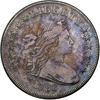 |
1798 Draped Bust Dollar. Small eagle reverse, 13 stars on obverse. PCGS graded VF-25. Medium silver gray toning with blue and russet near the rims. The obverse has some faint adjustment marks criss crossing at the center but no other surface marks worth noting. Late reverse die state, with multiple cracks through the legends. Not a particularly rare variety, but kept in high demand by type collectors who need the thirteen star, small eagle combination.
Estimated Value $2,000 - 2,500.
From the Benson collection and purchased from B. Max Mehl on May 4, 1946 for $35.00.
View details and enlarged photos
| Realized
$3,220 |
Lot 1157 |
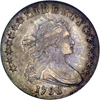 |
1798 Draped Bust Dollar. Heraldic eagle reverse, large eagle, 10 arrows. PCGS graded EF-45. A choice coin for the grade with natural yellow gray tones on both sides and well struck by the dies. This is a fairly early die state, with the die line above the right serif of the L in LIBERTY just forming. Minor adjustment marks on the reverse. Our consignor believes this coin to be double struck near the N of UNITED, but we could find no evidence of a second strike, but there are some adjustment marks in that area. Overall, this is a very nice coin for the variety or type collector.
As a quick aside, this is one of the most commonly misattributed Bust dollars, many times BB-108, B-13 is called BB-109 or B-10 in error. Both varieties were struck with the same obverse die, and the reverse is similar but can quickly be told apart by the three lower stars above the right wing and scroll, on the BB-108, B-13, the middle star is below the line formed between the three stars, on the rare BB-109, B-10, the middle star is above the imaginary line.
Estimated Value $2,000 - 3,000.
From the John Haugh collection.
View details and enlarged photos
| Realized
$2,760 |
Lot 1158 |
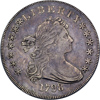 |
1798 Draped Bust Dollar. Heraldic eagle reverse, close date. ICG graded EF-45. A scarce die variety and interesting late die state. Light silvery gray in color with traces of luster in the protected areas. Although ICG calls this a "10 arrows" reverse, it is actually a 13 arrow reverse, 3 of the arrows being faint but visible with a glass. Sharply struck by the dies, and quite a nice coin overall with no signs of adjustment marks, rim knocks or similar problems. One minor planchet streak through ST of STATES.
Estimated Value $1,400 - 1,700.
View details and enlarged photos
| Realized
$2,185 |
Lot 1159 |
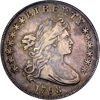 |
1798 Draped Bust Dollar. Heraldic eagle reverse, close date. ANACS graded EF-40. A scarce die pairing which is not fully appreciated by variety collectors. The obverse die broke early, and all seen to date have a bisecting crack through the 1 of the date to the E of LIBERTY, which produces a curious "V" area in the hair below that letter. This coin appears to be close to Bowers die state III or a bit earlier, as the crack isn't visible above Liberty's head. Lovely dark gray in the fields with lighter silver on the devices of the obverse, the reverse with multicolored tones within the devices which come alive when the coin is examined. The rims, surfaces and devices are all totally problem free and this coin is very choice for the grade. This might be at the low end of the condition census, but there are several known in approximately this grade, with a single mint state coin known.
Estimated Value $1,250 - 2,000.
From the John Haugh collection.
View details and enlarged photos
| Realized
$1,725 |
Lot 1160 |
 |
1798 Draped Bust Dollar. Heraldic eagle reverse, close date. ANACS graded VF-25. One of the classic rarities of the Bust dollar series, the obverse die broke quickly with a heavy crack from the rim near the first star to the tops of the 179 of the date. Nearly every coin seen of this variety is a different die state with the crack growing progressively worse with every coin struck. A few are seen with only a trace of the crack, which starts between the 17 of the date and makes its way to the left towards the rim below the first star. This particular coin is actually a fairly early state, with the crack heavy over the 179, but weak by the time it nears the star. Toned with dark gray hues in the fields, lighter silver on the devices, which are well struck. There are several rim knocks, including two over RTY and another below the first star, and other smaller ones on the obverse. On the reverse, we see rim marks over the first A of AMERICA and other smaller ones as well. No other circulation problems worthy of note, and a very rare coin in all grades, with perhaps 30 known in all.
Estimated Value $2,500 - 3,500.
From the John Haugh collection.
View details and enlarged photos
| Unsold |
Lot 1161 |
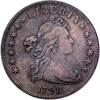 |
1798 Draped Bust Dollar. Heraldic eagle reverse, close date. ANACS graded VF-25. Here is another rare double struck Bust dollar. The entire reverse is sharply doubled, with a healthy shift between the strikes. There is no evidence of doubling on the obverse. Dark gray toning with minor verdigris hidden in the devices, and we note faint surface scratches in the right obverse field. For the variety, this coin may be near the lower end of the Condition Census, and more work will be done on that in the near future. Certainly a rare coin in even moderate grades, and to find an error of this variety is quite unusual. Identifiable by a rim bump below the arrow feathers, and of course, the double striking on the reverse.
Estimated Value $1,500 - 2,500.
Purchased privately by John Haugh from Jonathan Kern.
View details and enlarged photos
| Realized
$3,565 |
Lot 1162 |
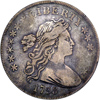 |
1798 Draped Bust Dollar. Heraldic eagle reverse, close date. PCGS graded VF-20. An extremely rare coin in any grade, this die pairing was first discovered about 25 years ago, and only a few have been offered over the years. First the obverse die was used to coin the 13 star small eagle coins, then the new heraldic eagle reverse die was paired with this obverse. Therefore, it is logical to assume that this was the first silver dollars of the heraldic eagle variety coined in 1798. The dies were not properly aligned, and this variety is virtually always weak on the sixth and seventh star and the L of LIBERTY. Further, the obverse die cracks with a break from the rim to the bust near the 8, and another through the third and fourth stars to the ribbon. These cracks, and unusual die swelling, combined to make the obverse and reverse dies appear oblong, and slightly out of round. The coin itself is truly round, and this was checked prior to submission to PCGS. Toned with deep steel gray in the fields, lighter on the devices on both sides. Identifiable by a small edge nick above the Y on the obverse, and on the reverse by light adjustment marks near OF and a thin scratch through the upper right side of the shield. As to the Condition Census of a dozen coins, this one is probably near the lower end, but all the higher grade examples we've seen are tied up in specialized variety collections. One of the rarest of all Bust dollar varieties, and anyone who is serious about these coins should put this one away as it may not be offered again for many years.
Estimated Value $4,000 - 6,500.
This coin was a duplicate owned by H. Rolland Willasch and sold to Jim Matthews via Julian Leidman in February 1989, it next appeared in Bowers & Merena's Alexander Sale, November 1996, lot 2001 then to the John Haugh collection.
View details and enlarged photos
| Realized
$4,255 |
Lot 1163 |
 |
1798 Draped Bust Dollar. Heraldic eagle reverse, close date. PCGS graded VF-20. A very late die state example of this popular variety, this is Bowers die state VII with the heavy crack extending to the last star at the upper point and the area above Liberty's head is starting to mound as seen in the final die state seen. As the obverse die was failing with the heavy pair of cracks from the last star, the centers are always weakly struck. Lovely steel gray fields with lighter silver on the devices. Faint adjustment marks are present on the obverse boarder, and a few shallow scrapes are noted on Liberty. Overall, this is a very nice coin for the moderate grade assigned, and a rare and desirable die state for the specialist.
This is a very interesting die progression, initially the obverse die forms swelling through Liberty's hair, and soon a crack forms through the lower 3 points of the last star. The coiner noticed the obverse crack, removed the die and lapped the crack out, and a few examples are known that show mounding where the original crack was, but it was literally erased from the die with a file of some sort (Bolender 11-a, Bowers State IV), as the die continued to strike more coins, it broke again, this time through the top point of the last star through Liberty's mouth to the back of her head into the field below L. As last the die was retired, but not before it produced one of the most interesting die progressions in the entire Bust dollar series.
Estimated Value $1,500 - 2,500.
From the John Haugh collection.
View details and enlarged photos
| Realized
$1,553 |
Lot 1164 |
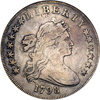 |
1798 Draped Bust Dollar. Heraldic eagle reverse, close date. ANACS graded VF-20. While not a rare variety, this later die state and somewhat scarce as such. The central obverse is both weakly struck and with just enough wear that the graders were not too generous, while the reverse has sharp wing feathers and appears to be a grade higher. The auction will decide, as always. Steel gray and pleasing, with problem free rims and surfaces throughout.
Estimated Value $750 - 1,000.
From the John Haugh collection.
View details and enlarged photos
| Realized
$1,093 |
Lot 1165 |
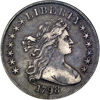 |
1798 Draped Bust Dollar. Heraldic eagle reverse, wide date, 13 arrows. ANACS graded VF-35. Dark steel gray and very nice for the moderate grade assigned. This variety is always weakly struck above the eagle, with a few of the stars flat or missing, as well as a cloud, and this was caused several die cracks and by the lack of metal moving when the coin was struck, with high demands to fill Liberty's bust, there wasn't enough pressure to fill in the stars which are opposite. Just missing the condition census, this coin should still bring a premium for the variety.
Estimated Value $1,250 - 2,000.
From the John Haugh collection.
View details and enlarged photos
| Realized
$1,323 |
Lot 1166 |
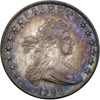 |
1799 Draped Bust Dollar. Normal date. PCGS graded AU-50. Head and shoulders above the average bust dollar, even for this 1799, which is the most common date in high grade. Desirable blue and gold toning enhances both sides, giving the coin an antique appearance. As with most 1799 dollars, the strike is strong, and only a trace of weakness is noted on the upper reverse stars and the eagle's head. Average handling marks, including a faint pin scratch through Liberty's mouth, and another up from the inside point of star ten. This is a slightly better variety, which in this grade is probably in the top dozen known for the die pairing.
Estimated Value $2,500 - 3,000.
From the Benson collection and purchased from B. Max Mehl on May 4, 1946 for $20.00.
View details and enlarged photos
| Realized
$3,795 |
Lot 1167 |
 |
1799 Draped Bust Dollar. Normal date. ANACS graded AU-50. Deep steel gray in color, with the fields and devices the same color. Fairly well struck, with no signs of weakness anywhere. The surfaces show no adjustment marks or other post minting problems, but there are some scattered specks on the obverse. This is Bowers die state III, the most often seen for the variety. Not in the condition census, but a nice collector coin that could probably be improved by someone knowledgable in this area.
Estimated Value $2,000 - 3,250.
From the John Haugh collection.
View details and enlarged photos
| Realized
$2,415 |
Lot 1168 |
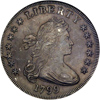 |
1799 Draped Bust Dollar. Normal date. ANACS graded EF-40. Toned a dull steel gray, probably from an ancient cleaning and retoning, a bit of luster still remains near the devices. This is an example of the later die state IV per Bowers, with the obverse cracks through the first three stars to the date, and an additional crack on the reverse at the D of UNITED. We feel that this coin was net graded by ANACS because of some hidden scratches on Liberty's drapery, and more bagmarks than one would expect for the grade. Nevertheless, the coin has lots of detail, and is of the desirable late die state, which should be worth a look from specialists.
Estimated Value $1,000 - 1,750.
From the John Haugh collection.
View details and enlarged photos
| Realized
$1,840 |
Lot 1169 |
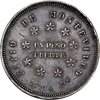 |
1799 Draped Bust Dollar. Normal date. EF-40. An extremely rare coin, either way you look at it! First, the 1844 Uruguay Un Peso Fuerte was struck during the civil war siege of Montevideo at the Mint located there. Silver from all available sources was gathered up and struck without the usual refining or other preparation, and thus many show undertypes from Latin Pesos and two show undertypes of United States Bust silver dollars, which were apparently in circulation in Uruguay during 1844. One of these was sold in Kagin's 1983 ANA Sale, lot 1722, and this coin now resides permanently in the ANS. This is the other example with the Bust dollar undertype. After careful research, the undertype Bust dollar is almost certainly a 1799 BB-164, B-17 Bust dollar. This was determined by close examination of the arrowheads and UNITED STAT, which are the most visible portion of the undertype. To attribute this coin note that the first arrowhead ends about midway under the U of UNITED, and using a strong glass a hint of the die crack on the 1799 BB-164, B-17 can be seen through the middle of the U to the base of the N, another crack is seen through the ST of STATES, and the position of the T of STATES over the cloud seems to confirm that this variety was used for the host coin.
While the 1844 Uruguay Un Peso Fuerte is rare in its own right, but struck over a United States Bust dollar makes it extremely desirable! The surfaces are steel gray in color, and there are no surface problems of any kind. The undertype of the Bust dollar is visible on both the obverse and reverse, with most of the arrows, UNITED STATE and part of eagle's right wing clear with a glass. The only other overstrike involving a Bust dollar that we know of is the 1804 dollar struck over an 1857 Bern Shooting Thaler. An extremely rare and desirable example of countries borrowing from each other to make their own sovereign coinage. Additional suggested sources of information are Alcedo Almanzar and Dale Seppa in Coins of Uruguay, 1971, and Coin World articles on these overstrikes dated September 20, 1993 and November 15, 1993 and possibly Freeman Craig, who is a noted authority on these issues. Our thanks to researcher W. David Perkins for this information.
Estimated Value $4,000 - 6,500.
From Superior's sale circa 1992 and sold privately in August 1993, it also appeared in a Ponterio auction circa 1997-98, then next in Bowers and Merena's LaRiviere Part III Sale, May 2001, lot 23, and the John Haugh Collection.
View details and enlarged photos
| Realized
$6,670 |
Lot 1170 |
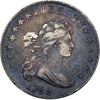 |
1799 Draped Bust Dollar. Normal date. EF-40. Charcoal black toning on both sides with slightly lighter color on the devices, and this one has been cleaned in the past. The reverse die state is very late, with complex cracks through the legends and devices. There are some small marks about the rims on both sides.
Estimated Value $1,300 - 1,500.
View details and enlarged photos
| Unsold |
Lot 1171 |
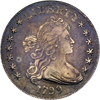 |
1799 Draped Bust Dollar. Normal date. ANACS graded VF-35. A scarce variety that is seldom offered, aside from the large hoard in the Bowers 1989 ANA sale which contained 26 pieces. This coin does not seem to be from that hoard. One small field dig is located at the inside of the fifth star, and another scrape is noted at the top of the branch on the reverse. As always seen, the reverse die is broken with a rim to rim horizontal crack which extends through the wings and upper chest of the eagle. Curiously, the reverse is always much sharper struck than the obverse, which is notoriously weak. Virtually all known of this variety grade EF or lower, as the weakness on Liberty always grades this variety down, while the reverse is always a higher grade.
Estimated Value $1,250 - 2,000.
From the John Haugh collection.
View details and enlarged photos
| Realized
$1,553 |
Lot 1172 |
 |
1799 Draped Bust Dollar. Normal date. PCGS graded VF-30. A slightly better variety for the year, this one boasts mottled gold and blue toning around the rims, and generally silver gray at the centers. We note a nick on Liberty's jaw and a couple of similar ones hidden in her hair. Smooth rims and average surfaces for the grade, and appealing for the color. This one comes with an ancient coin envelope written with a quill pen.
Estimated Value $1,000 - 1,200.
From the Benson collection and purchased from Ira S. Reed in May, 1944 for $17.50 and make sure to get the very old coin envelope with this one.
View details and enlarged photos
| Realized
$1,150 |
Lot 1173 |
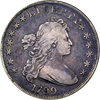 |
1799 Draped Bust Dollar. Normal date. ANACS graded VF-20. Steel gray in color and nice for the grade. There are a few faint scratches, but they are not too distracting. Well struck by the dies, with the usual die cracks through the reverse legends. One hidden gouge on the left wing of the eagle. Our consignor believes this coin was double struck, but we could find no trace of another strike.
Estimated Value $750 - 1,250.
From the John Haugh collection.
View details and enlarged photos
| Realized
$978 |
Lot 1174 |
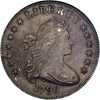 |
1799 Draped Bust Dollar. Normal date. ANACS graded Fine-15. The evidence of the flipover double strike is in the left obverse field, where the claw and arrow shafts can be seen second through fourth stars. As to the coin itself, the surfaces are steel gray in color, with problem free wear. We could find no trace of undertype on the reverse. An affordable example of a rare Bust dollar error.
Estimated Value $1,000 - 1,750.
From the John Haugh collection.
View details and enlarged photos
| Realized
$1,783 |
Lot 1175 |
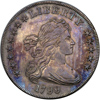 |
1799 Draped Bust Dollar. 8 stars left, 5 right. EF-40. Steel gray toning on both sides with hints of blue and gold too. Well struck for this variety, with strong curls on Liberty and all the stars complete over the eagle. The surfaces appear to have been cleaned long ago with trivial lines on the surfaces, but nicely toned today so as not to bother us. One small nick located on the dentils above the E of LIBERTY, but this coin is far nicer than the majority seen of the variety. Over the last decade, few of these have been offered in high grade, and we anticipate strong action for this prize when it crosses the block. Always in strong demand for the unique obverse star combination, and many collectors require one for their Red Book collections, keeping prices for this variety high. To find a high grade example usually takes some patience.
Estimated Value $1,200 - 1,500.
From the Benson collection and purchased from B. Max Mehl on May 4, 1946 for $35.00.
View details and enlarged photos
| Realized
$1,955 |
Lot 1176 |
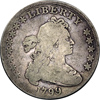 |
1799 Draped Bust Dollar. 8 stars left, 5 right. VG-8. Although a moderate grade, this coin is a delight to behold. First of all, it is the scarce 8 X 5 stars obverse, which was only used on this one die variety, and has been listed in the Guide Book for many years as an important major type variety. Second, this is a dramatic error, not just a double strike, but the coin flipped over between strikes, so the eagle's wing and scroll are visible on the bust, and best of all, Liberty's face gazes upwards from the star field above the eagle's head! This coin was subject to an article in the Coin World issue of August 12, 1996. The surfaces are very clean for the grade, and the fields are medium gray while the device lighter. Other traces of the initial strike are present, but most of this was obliterated by the second strike. An impressive error for the specialist.
Estimated Value $1,250 - 2,000.
From Bowers and Merena's LaRiviere part II Sale, March 2001, lot 344 and the John Haugh collection.
View details and enlarged photos
| Realized
$4,830 |
Lot 1177 |
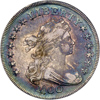 |
1800 Draped Bust Dollar. NGC graded AU-55. This is perhaps the finest known flip over double strike in the Bust dollar series, as all such coins are rare, and we've never heard of another high grade one like this! Further, this is the "Super Liberty" because the second S of STATES is centered directly on her chest drapery. In addition, the date can be made out on the reverse around the right wing as you face the eagle, with portions of the 18 on the wing, and the 00 located on OF. Most of the first strike was obliterated by the second, but enough remains to show that this is clearly something special. Gorgeous colors throughout, with deep blue at the rims, rose and gold elsewhere, and quite lustrous in the fields. One tiny dig is noted above the 8 in the date. We note a couple of rim marks above LIBERTY, but they are hard to see in the holder. An opportunity for the specialist to snag something really fun.
Estimated Value $3,500 - 7,000.
Purchased from J.J. Teaparty at the Portland ANA in 1998 by W. David Perkins, and sold later to John Haugh.
View details and enlarged photos
| Realized
$8,338 |
Lot 1178 |
|
1800 Draped Bust Dollar. AU-53. Lovely antique gray toning on both sides and very original. Well struck on the obverse, with excellent definition on the upper curls of Liberty, and well centered too, with long dentils surrounding. On the reverse the die was cracked, which allowed for minor weakness on the right side of the shield and wing. This is actually a much later die state than mentioned in Bolender, but others have been seen with the shattered reverse as seen here. Problem free for the date and grade, with no significant rim marks or adjustment marks, just a very pleasing coin from an old time collection.
Estimated Value $3,000 - 3,500.
View details
| Realized
$3,565 |
Lot 1179 |
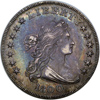 |
1800 Draped Bust Dollar. PCGS graded AU-50. This coin is just about perfect for the grade. Dark gray and blue toning on both sides, clean surfaces and just a touch of wear on the high points of the design. This is a later die state, with faint cracks through the legend on the reverse, and a clash mark located near Liberty's bust from the eagle's wing. Identifiable by a very faint pin scratch below UNITE on the reverse and a tiny mark in the field just over the eagle's head. As perfect for the grade as any bust dollar seen. This particular coin is not noted in the Bowers-Borckardt survey, and is probably at the low end of the top dozen known for the variety. Bowers die state IV, and we note strong clash marks from the eagle's wing above and below Liberty's bust on the obverse, and faint drapery lines below OF in the field. There are two faint breaks through the C of AMERICA, and another through ER. Note also that the reverse die is rotated about 20 degrees counterclockwise.
Estimated Value $2,800 - 3,200.
From the Benson collection and purchased from Ira S. Reed in his final sale of March 30, 1946 for $21.00.
View details and enlarged photos
| Realized
$4,830 |
Lot 1180 |
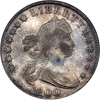 |
1800 Draped Bust Dollar. ANACS graded EF-45. Light silvery gray in color, with minor hairlines in the fields from a past cleaning. Some luster resides near the devices. Struck after the reverse die clashed with the obverse, with the familiar "spray" of lines connecting two stars to the clouds, the clash marks are from Liberty's drapery lines. Overall, this coin has better than average eye appeal and color, and the surfaces are decent for the grade.
Estimated Value $1,250 - 2,000.
From the John Haugh collection.
View details and enlarged photos
| Realized
$1,610 |
Lot 1181 |
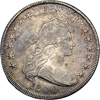 |
1800 Draped Bust Dollar. VF-30 or better. A rare die state of this underappreciated variety! The obverse die cracked apart, quickly terminating its use soon after this one was struck. Note the heavy die crack through the B of LIBERTY to the first star, and another through the 1 in the date up into Liberty's hair, other small cracks are present too. Die swelling at Liberty's ribbon, with no definition at the back, as seen on this die state. Curiously, the coin does not appear to be round, the obverse die shattered before this one was struck and cracks can be seen through the date to the top, with severe die swelling on Liberty's ribbon. It is apparent that the coin is not perfectly round, and it is likely that the dies were also out of round and produced a slightly elliptical coin. Other late die state examples of this coin have this same unusual feature. The reverse die is rotated counter clockwise about 20 degrees. Silvery gray in color,with just a bit of toning, and traces of luster are noted in the protected areas. One small toning streak between TY of LIBERTY should help trace the pedigree. This variety was missing from the Blevins collection, and many other specialists have had difficulty in locating a nice specimen beyond what is expected for the rarity assigned.
Estimated Value $1,500 - 2,500.
From Bowers & Merena's LaRiviere Part II sale, March 2001, lot 348 and the John Haugh collection.
View details and enlarged photos
| Realized
$1,898 |
Lot 1182 |
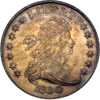 |
1800 Draped Bust Dollar. "AMERICAI". ANACS graded AU-50. This is the more common of the two varieties which were struck with this reverse die, both of which show the curious die line or die scratch after the last A of AMERICA, appearing to be an "I", but in reality is probably the right side of a repunched "A" or some sort of error in cutting the stem of the branch. The other quick identifier for this variety is the small die line located below the first star. Toned with golden highlights over lustrous surfaces, we do note moderate hairlines beneath, but this is still a pleasing example for the variety or type collector. Identifiable by a small vertical mark at the center of the eagle's chest.
Estimated Value $2,500 - 3,500.
From the John Haugh collection.
View details and enlarged photos
| Realized
$2,990 |
Lot 1183 |
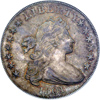 |
1801 Draped Bust Dollar. . B-2. PCGS graded AU-58. Gorgeous original toning on both sides, the obverse deep gray with ample russet and red hues near the devices, the reverse similar with even brighter colors set off by the luster in the fields. Average handling marks expected for the near mint state grade, and a few old hairlines too. 1801 silver dollars are very scarce in higher grades as seen here, PCGS has graded 8 this high, and importantly only 3 as mint state above. Don't delude yourself into thinking this is a "common" date bust dollar. As to the strike, this one is decent, with definition on Liberty's curls save for the uppermost ones that show light wear. Identifiable by a very minor pin scratch through the lower left side of the O in OF up to the left through the rim.
Estimated Value $9,000 - 11,000.
Purchased privately several years ago from a prominent dealer.
View details and enlarged photos
| Realized
$18,400 |
Lot 1184 |
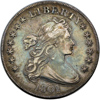 |
1801 Draped Bust Dollar. PCGS graded VF-35. Bluish gray in color on the obverse, golden gray on the reverse. A sharp strike and minimal handling marks.This variety pairs a common obverse die with a reverse die that has no right serif on the base of the letter T on the reverse, which appears 3 times.
Estimated Value $1,200 - 1,500.
From the Benson collection and purchased from Ira S. Reed around 1946.
View details and enlarged photos
| Realized
$2,070 |
Lot 1185 |
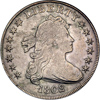 |
1802 Draped Bust Dollar. 2 over 1, narrow date. ANACS graded VF-30. A rare variety that is seldom offered, this coin has the diagnostic lump below the B on the obverse, and the reverse "B" which was used on several die pairings from 1801 to 1803, quickly identifiable by a lump on the lower right curve of the D of UNITED. This is Bowers die state III, and rare as such. Most coins show the obverse crack from the rim to the bust, and this probably terminated the dies use before many were struck. Light gray in color and probably cleaned long ago, but all in all, a well struck, well preserved example of this die pairing. Far and away the rarest of the 1802, 2 over 1 varieties. Our consigner considers this coin to be under graded, and as always, the market will decide the value.
Estimated Value $1,500 - 2,500.
From the John Haugh collection.
View details and enlarged photos
| Realized
$2,530 |
Lot 1186 |
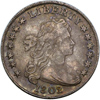 |
1802 Draped Bust Dollar. 2 over 1, wide date. PCGS graded VF-35. Soft medium gray in color, with darker hues in the stars and periphery. We note a wide but shallow scrape from just under Liberty's nose to the curls behind her ear, and another tiny scratch on the fourth feather up on the left wing. The color is a matte gray. Not the prettiest coin in the sale, but it sure has a great pedigree.
Estimated Value $1,200 - 1,500.
From the Benson collection and purchased from Numismatic Galleries 1946 ANA Convention Sale, August 20, 1946, lot 1318, with envelope included.
View details and enlarged photos
| Realized
$1,725 |
Lot 1187 |
 |
1802 Draped Bust Dollar. 2 over 1, wide date. ANACS graded VF-30. A scarce and under appreciated variety that is difficult to locate in high grade. This particular coin boasts some luster in the protected areas, and is golden gray in color. Identifiable by a small mark in the right obverse field between Liberty's chin and the eleventh and twelfth stars, and a small dark toning spot hidden in her lower hair, at the level of the junction of her neck and drapery. Overall, this one has nice surfaces, rims and color, and is probably at the lower end of the condition census for the variety, although this hasn't been updated for several years.
Estimated Value $1,250 - 1,750.
From the John Haugh collection.
View details and enlarged photos
| Realized
$1,783 |
Lot 1188 |
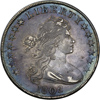 |
1802 Draped Bust Dollar. Narrow normal date. PCGS graded EF-40. Medium steel gray and choice overall, but we note a dark streak through the lower right obverse, possibly from a rubber band. Of all the known bust dollars, this is one of the most common varieties. For some reason, these dies just kept on going, and thousands upon thousands were struck. The BB-241, B-6 is quickly recognizable by the missing right foot (serif) on the T of LIBERTY, and the reverse has a small die break connecting the second feather from the top to the rim on the left wing of the eagle. The broken T punch was also used on the reverse of 1801 BB-213, B-3. Overall, this is still a nice coin for the grade assigned.
Estimated Value $1,500 - 1,700.
From the Benson collection and purchased from David Bullowa on May 25, 1946 for $14.00. It is interesting to note here that Ira S. Reed sold his coin business to David Bullowa in early 1946.
View details and enlarged photos
| Realized
$2,530 |
|
|